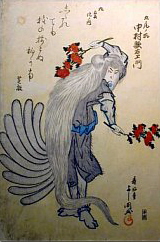|
|
|
|
FOX LORE FROM KOREA
THIS IS A SIDE PAGE
Return to Main Inari & Fox Page
|

Nine-tailed Fox. Japanese
woodblock by Yoshikun;
from Charles Hovey
Pepper collection
|
|
Kumiho (Nine-Tailed Fox)
Below text by Charles La Shure. Kumiho literally means "nine-tailed fox," and this creature appears commonly in the oral tales of Korea. Unlike Japan, where the fox is considered a benevolent creature, in Korea it is always depicted as evil. It can freely transform into, among other things, a bewitching female who seduces men. A fox that lives a thousand years is said to turn into a kumiho. There are a number of legendary tales in which the kumiho appears. A half dozen or so of those legendary tales can be found in the encyclopedic Compendium of Korean Oral Literature (Hanguk kubimunhak taegye). A quick look at them will help supplement the brief description given above.
In "Transformation of the Kumiho" ("Kumihoui pyeonshin"), a kumiho transforms into an identical likeness of a bride at a wedding, and not even the bride's mother can tell them apart. The kumiho is finally discovered when her clothes are removed. In "Pak Munsu and the Kumiho" ("Pakmunsuwa kumiho"), the famous character Pak Munsu encounters a girl living alone in the woods who has a distinctly fox-like appearance. "The King and the Kumiho" ("Wanggwa kumiho") tells of a king who meets a girl in the woods at night and tells her to take off her clothes after promising to save her debt-laden father. The tale records that it was too dark for the king to see whether she was actually a girl or a fox, indicating that if it had been light the difference would have been obvious. In "The Maiden who Discovered a Kumiho through a Chinese Poem" ("Hansiro kumihoreul aranaen ch'eonyeo") we read that the kumiho was ultimately revealed when a hunting dog caught the scent of the fox and attacked. All of these details would seem to indicate that, while the kumiho may be able to change its appearance, there is still something fox-like about it; its countenance changes, but its nature does not.
The kumiho is typically pictured as taking a female form when transforming into a human being (as indicated in the encyclopedia entries), but the kumiho in "The Maiden who Discovered a Kumiho through a Chinese Poem" turns into a young man who attempts to trick the maiden into marrying him. It should be noted that this is the only case where the kumiho transforms into a man; in the rest of the tales the kumiho takes the form of a beautiful girl.
Although it is not indicated in the encyclopedia entry quoted above, the kumiho is not a benign trickster who delights only in fooling people. There is no doubt that the kumiho is an evil creature; unlike the fox of Japanese folklore, who will sometimes change into a woman to marry a man who has been kind to it, the kumiho never appears as a benevolent figure. The kumiho encountered by Pak Munsu intended to harm him, but he was able to escape. Likewise, the amorous king was saved by the timely arrival of a mountain spirit who struck the kumiho on the cheek and forced her to reveal her true form. Others were not so lucky. In "The Hunter and the Kumiho" ("P'osuwa kumiho"), a hunter comes upon a fox scratching at a human skull in the woods. Before his eyes, the fox changed into an old woman and went down into a nearby village (the scratching of the skull and the subsequent metamorphosis introduces an element of sympathetic magic into the kumiho's transformation, but there is not space enough here to flesh out this aspect). The hunter followed and saw her "reunited" with her children, who had puzzled over her absence of several months. The hunter was able to warn the children that their mother had been killed by the kumiho, and the kumiho intended them to be her next victims. "The Emperor's Kumiho Daughter-in-Law" tells of us a Chinese emperor's son who married a kumiho. After the marriage, the country's retainers mysteriously began to die one by one. The tale's hero eventually discovered the kumiho and was given permission by the emperor to kill it and save the remaining retainers. The kumiho of "The Kumiho and the Samjokku (Three-legged Dog)" ("Kumihowa samjokku") is married to another Chinese emperor, and she shows vampiric tendencies in wanting to suck the blood from her intended victim, the hero of the tale (she is foiled by the hero's three-legged dog, who attacks and kills her).
Although this is by no means a complete survey of kumiho tales, it should suffice to supplement the brief definition we began with. Through these tales we can see just how intriguing a character the kumiho is, reflecting in its complex nature aspects found in various characters familiar to a Western audience: the trickster, the fiend, the succubus, and even the vampire. The kumiho continues to live on today as one of the few truly evil creatures of Korean folklore.
Sources:
- Donga wonsaek segye paekhwasajeon
- Dusan segye taebaekhwasajeon
- Hanguk kubimunhak taegye
THIS IS A SIDE PAGE
Return to Main Inari & Fox Page
|
|